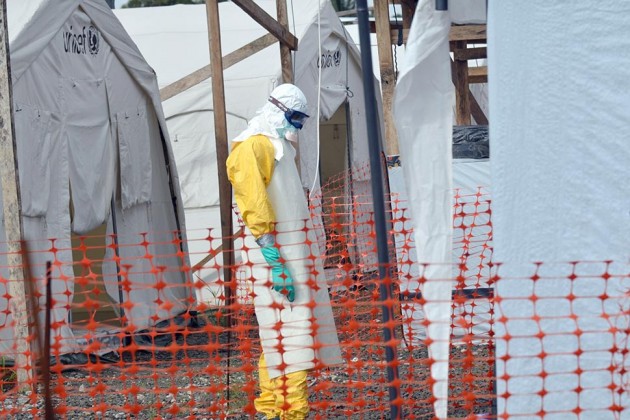NEWS
October 30, 2014

IN BRIEF
By: John Tozzi. This article was originally published by Bloomberg Business. The fight against Ebola is taking place on two well-known fronts: on the ground in West Africa, where governments and aid groups are racing to build treatment centers; and inside the lab, where scientists are trying to create vaccines and therapies to halt transmission. A third battleground, harder to track but no less important, focuses on efforts to win trust and change the behavior of the people most at risk of spreading the virus. It’s something many global aid groups were late to. “A huge mistake of the outbreak from [...]
SHARE
“A huge mistake of the outbreak from the start has been that people have responded to the outbreak from the outside without really getting the people on board,” says Emmanuel d’Harcourt, senior health director of the International Rescue Committee, which has worked in Liberia and Sierra Leone for more than 15 years. “That, from our perspective, is a massively under-recognized problem.”
A lot is riding on how well the global response engages the local communities in places where Ebola has spread. The virus has now infected more than 13,000 people in Guinea, Liberia, and Sierra Leone, according to the World Health Organization. The three countries are home to 21 million people. The population is mostly young—more than 60 percent are under age 25—and largely rural. Literacy is low, poverty is high. So is mistrust of government, particularly with the fresh legacy of civil wars in Liberia and Sierra Leone. How people respond when a family member develops symptoms or a neighbor dies has a great deal of consequence for how fast Ebola spreads.
“In a place like Liberia, rumors are reality for a lot of people,” says Blair Glencorse, executive director of Accountability Lab, which works in Liberia and other countries to help citizens hold the government accountable. Misconceptions about how Ebola is and isn’t transmitted—or whether it’s even real—can feed the spread of the virus. Glencorse says global aid in Liberia so far is “largely a technical response: How many beds can we provide? How many treatment centers can we set up?” Those are no doubt urgently needed, but the equipment alone is insufficient.
“People aren’t going to go to those treatment centers, even if they have the best facilities, if they believe that’s where you go to get Ebola,” Glencorse says. “There’s a danger that we build lots of treatment units, and then no one shows up.”
The world is puzzling over an apparent decline in the number of new Ebola cases in Liberia that has left empty beds in treatment centers. “The actual number of newly reported cases is beginning to decline in Liberia,” Dr. Bruce Aylward, the WHO official leading the response, told reporters on Wednesday from Geneva. Authorities are trying to determine whether the decline is real, or if it reflects changes in how people are reporting cases. “One of the big concerns is, does that mean people are not seeking care because they aren’t happy with how people are being treated potentially in facilities or how burials are being conducted?”
In every disaster is an official response and a grassroots response. The top-down nature of global aid—often driven by donors’ agendas, with shifting commitments and quick turnover of international staff—makes it challenging for governments or aid groups to credibly convey the messages that can get people to change behavior. The best messengers in Liberia are Liberians themselves. A handful of local projects have put community members first in campaigns against Ebola.
Glencorse says Liberian volunteers working with his group have trained citizen journalists who set up chalk boards at intersections in Monrovia to spread information about treatment centers and numbers to call if you get sick. Another effort, Kriterion Monrovia, is a youth group teaching community members about Ebola face to face.
Liberian volunteers coordinating with the Purdue Peace Project at Purdue University have been recruiting the drivers of motorcycle taxis in Monrovia to relay the facts about Ebola to their passengers. The 20 volunteers have reached 1,500 drivers, known as “pen-pen” drivers.
The early results of the campaign in September surprised Stacey Connaughton, director of the Purdue Peace Project. “People didn’t really think that Ebola was real,” she says. By the first week of September, more than 1,000 Liberians had died of the disease. “There is now recognition that it is very real,” Connaughton says, ”but there’s still a fundamental tension that citizens feel when they want to bury their dead in a traditional way and touch the body.”
It’s still hard to tell whether that growing recognition has stemmed the rise of new Ebola cases in Liberia or if persistent fear has kept people away from treatment wards. “The capacity to capture a true picture of the situation in Liberia remains hamstrung by underreporting of cases,” the WHO wrote in its latest situation report (pdf) this week, which casually notes that data on cases in Liberia are missing for five days in October. The WHO’s Aylward said he feared that a glimmer of good news would lull the world into complacency. “I’m terrified that the information will be misinterpreted and people will start to say, ‘Oh, great, Ebola is under control.’ That’s like saying your pet tiger is under control.”
Case counts continue to rise, and the epidemic shows no signs of slowing in Guinea or Sierra Leone. In the weeks ahead, the world will learn whether Liberia has actually slowed the increase in cases. Aylward warned of a danger “that we end up with an oscillating trend where the disease starts going up and down, areas start getting reinfected.”
More treatments beds and staff to trace contacts will be important to that battle. So will the work of taxi drivers, youth groups, and anyone else in Liberia who can cross the gap in trust between the world’s response to Ebola and the people who are at risk.
